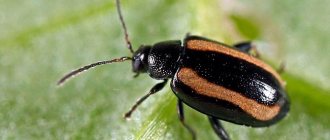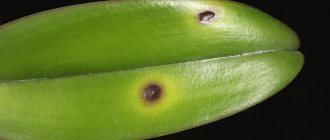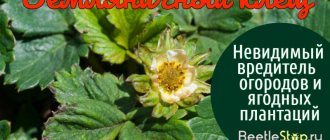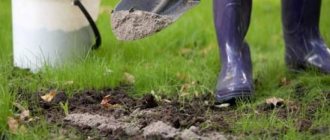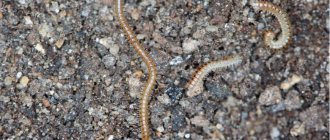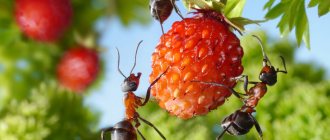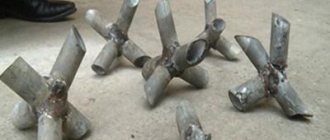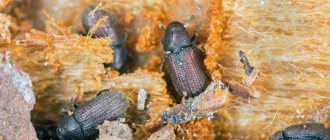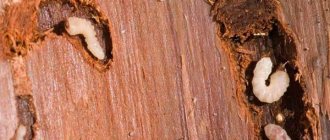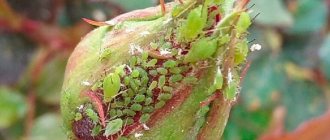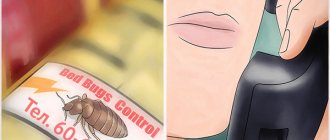The strawberry or strawberry nematode is a microscopic worm that causes enormous damage to plants. Affected plants stop growing actively and wither. In advanced cases, it leads to crop loss. It is difficult to completely get rid of this problem. The best way to combat nematodes can be timely prevention.
Dear readers! For you, we have created communities on social networks in which useful articles and interesting ideas are published several times a day! Subscribe and receive useful content in a convenient format!
Description
The nematode is a very voracious and tenacious pest. Even eggs can remain in the ground for up to 10 years , after which they hatch. It is not easy to detect; the size of this roundworm is from 1 millimeter to 2 centimeters.
What is a nematode - biological description
A nematode or Nematodes is a roundworm belonging to the phylum Protostomes.
The body color is white, sometimes yellowish. Males and females are easily distinguished by body shape. Females are rounder because they carry the eggs within themselves.
The nematode's mouthparts resemble small forceps. With the help of this organ, it is tightly attached to the stem or roots of garden strawberries. After which it actively feeds on the sap of the plant.
Reference! Eggs and adult nematode worms hide in the soil. This is an additional circumstance that makes them difficult to detect and remove.
Types of nematodes
It parasitizes not only strawberries, but also other plants. It could be:
- Golden potato. It affects exclusively plants of the Solanaceae family. The greatest danger is for potatoes. The leaves of the affected plant turn yellow and wither, flowers and tubers do not form;
- Root gall. It parasitizes exclusively on the roots of various vegetables. Each plant species is affected by its own subspecies of nematode. As a result, plants rapidly lose moisture. As a result, their development slows down and productivity decreases;
- Stem. It is most dangerous for plants such as garlic, onions, potatoes and some garden flowers;
- Leafy. These are colorless worms only 0.5 - 1 millimeter long. Lives in the leaves of many plants. Most often found on chrysanthemums, strawberries and tomatoes.
Strawberries or garden strawberries are affected by leaf and stem forms.
Attention! The most common parasite on garden strawberries is the stem nematode.
Preventive actions
To prevent the appearance of nematodes in the garden plot, all strawberry seedlings should be carefully inspected for pest damage before planting.
. All planting material must be of high quality.
If small white or yellowish inclusions are noticeable on the root system, this is the first sign of nematode damage to the strawberry
. But even if this is not found on the roots, the root system of the seedlings must be treated with hot water (47-50 C).
Before planting strawberries, compost is added to the beds, which contains beneficial fungi that prevent the development of this pest. Similar feeding is carried out during the active growing season.
It is important to know!
To prevent the nematode from actively spreading throughout the area, it is necessary to periodically change the place where strawberries are grown - this berry crop can be grown in one area for no more than 5 years.
Before planting strawberries, their roots are treated with 0.5% of the working fluid “Parathion” or “Fosdrin”. Strawberries should be kept in this solution for no more than half an hour. Then the roots are washed and the plants are immersed in hot water at a temperature of about 50 degrees Celsius for several minutes.
You also need to follow the rules of crop rotation and plant the right neighbors next to the strawberries.
. Usually, marigold bushes are planted next to this berry crop. Their aroma attracts the nematode, but the poisonous cell sap quickly leads to the death of these worms.
And the roots of nasturtiums and marigolds release a special substance into the ground that repels many pests, including nematodes.
It is also recommended to plant other plants along the edges of the beds, which repel pests with their smell:
- gaillardia is beautiful;
- Drumond;
- coreopsis.
Pictured is Creopsis
But there are a number of cultivated plants that will be undesirable neighbors for strawberries:
- tomatoes;
- celery;
- carrot;
- potato;
- beans;
- cabbage;
- peas.
They can get sick and be affected by some diseases and pests.
Nematode on strawberry
On strawberries it can radically reduce the yield of the plant. The best time for its development is in May - early June. It is at this time that flowering and fruit formation occur, which greatly weakens the plants. The berries become small and ugly and lose their attractive taste.
Peculiarities! Good prevention of nematode damage is varieties that are resistant to the effects of this pest.
What does the affected plant look like?
The nematode is extremely difficult to see with the naked eye. Its presence can be determined by indirect signs:
Swelling on the stem or leaf veins;- Shortening and curvature of petioles;
- Wrinkling and subsequent death of leaves;
- Deformation and reduction of the ovary;
- Specific swellings or galls form on the upper side of the leaves.
The growth of bushes slows down sharply, the plants seem to be “pressed” to the ground. Spreads through infected plants.
Reference! Infected seedlings can be identified upon inspection. In the earthen coma you can see white dots reminiscent of semolina. This is what female nematodes look like, filled with eggs.
What harm can it cause?
Different types of nematodes live in the soil. But they are dangerous only in high concentrations around the plant.
Attaching to the stem and leaves, the worms suck out the juice from them. At the same time, they inject a special chemical into the plant.
It makes the stem or leaves more suitable for the pest.
Another serious danger is the infection of damaged plants with infections.
The nematode becomes a serious threat at concentrations of more than 1,000 worms per square meter. This is possible due to the enormous fertility of females. At one time, they are capable of laying up to 2-000 eggs at a time.
Attention! The nematode additionally serves as a carrier of viral and fungal diseases.
Signs of plant damage and damage
Signs of damage are not specific. Kivsyaki gnaw holes of varying depths in the berries. But often inside the hole you can find a larva of a noose or even several larvae intertwined in a ball. Damaged berries acquire an unpleasant odor and cannot be used for food. In a cold and wet spring, nodule moths can damage the root system and underground part of the stems of many crops, gnawing out small cavities in them. The affected areas turn brown or black. Plant development slows down, and if severely damaged, they dry out and die. In cases where woodlice and woodlice are present in the soil together with woodlice, the damage to cultivated plants is most serious.
Kivsyak in strawberries
How to fight the disease
Once a nematode appears, it will be quite difficult to get rid of it. The removal process from the site may take longer than 3 months. The following methods can be used for this:
- Agronomic (these include deep digging of the earth, soil optimization and changing the planting site);
- Mechanical (treatment of the root system of plants with hot water);
- Chemical (nematicide treatment);
- Biological (planting plants next to the bed, the proximity of which is not tolerated by nematodes).
More information about the fight against nematodes can be found in the video below:
Severely affected bushes should be destroyed immediately. This will prevent infection of healthy plants. The best effect is achieved by a combination of these measures.
Reference! It is impossible to completely get rid of nematodes from an area. But you can reduce its amount to an acceptable amount.
Method of treatment with folk remedies
Proven folk remedies include hot water treatment. The method is effective at the initial stage of root infection. Thus, it is possible to “cure” seedlings if female nematodes are found in the root coma of the soil. For this:
- Dig up a mature bush. If we are talking about seedlings, they are carefully removed from the pots;
- Thoroughly wash off the soil and nematodes from the roots. This water should not be used for watering other plants or for composting;
- The roots of the plant are immersed in a container of water. A water temperature of 45 - 50 C will ensure the death of not only adult worms, but also eggs. Do not use hotter water so as not to damage the bush. Keep for 5 to 20 minutes.
After this, the bush is carefully transplanted to a new place and watered abundantly. Spraying with decoctions of plants that are poisonous to nematodes also has a good effect. It can be:
- Marigolds (1 kilogram of inflorescences per 10 liters of water, spray the bushes with a filtered solution;
- Calendula (1 spoon of flowers per 1 liter of water);
- Large nasturtium (300 grams of plants per 1 liter of water);
- Onion (30 grams of dry plant per 5 liters of water).
Unlike chemical nematodocytes, spraying with plant products can be done during flowering and ovary formation.
How to treat with chemicals
The most popular nematicides include:
Mercaptophos;- Ruskamin;
- Lindan;
- Heterophos;
- Phosphamtide.
The solution is prepared and used according to the instructions included with the drug. Treatment is usually carried out before flowering begins.
It is recommended to carry out excavation work after treatment only after 45 days.
Carefully! Nematicides are highly toxic. Work must be carried out using personal protective equipment. These include a respirator, gloves and thick clothing.
Strawberry varieties resistant to nematodes
If the site already has such a problem, it is worth paying special attention to prevention.
One of the most effective measures is the use of pest-resistant varieties. The most popular of them:
- Festival;
- Saxon;
- Granddaughter;
- Pearl mussel;
- Rocket.
At the same time, they have strong immunity to viral and fungal infections.
Peculiarities! The use of resistant varieties is the prevention of the most dangerous fungal diseases of garden strawberries.
Folk remedies
If the situation is not advanced or you simply don’t want to use chemicals, there is an alternative option than treating the berry plantation. Use folk remedies that are not so aggressive.
- Hot water
Since the nematode settles mainly on rhizomes and is afraid of elevated temperatures, it is recommended to spill the infected bed with hot water (no more than 55°C).
- Flower infusions
The juice of some plants acts as a poison on roundworms. Based on them, you can prepare infusions and pour them over strawberries. Usually marigolds or marigolds are used. Take 1 kg of flowers, crush them, add 5 liters of warm water, infuse them covered in a warm place for 2 days and strain. Use every other day.
- Onion infusion
Soak 200 g of leeks in 5 liters of warm water for a day. Strain. Use for watering and irrigation once a week.
- Ammonia
Rub a piece of laundry soap (72%), pour 1 liter of hot water into it, and beat thoroughly until a thick foam forms. Pour a bottle of 10% ammonia into another container with 1 liter of water at room temperature. Mix. Pour both resulting solutions into a bucket with 8 liters of water prepared in advance. After thoroughly mixing, without leaving for later, pour over the strawberries. Judging by the reviews, the product helps well against root nematodes.
Folk remedies are effective mainly in the early stages of infection or for preventive purposes.
Prevention measures
Measures to prevent nematode infection include:
- High-quality planting material. Most often, infection occurs through infected seedlings. It is worth purchasing it in nurseries or trusted stores;
- Pre-planting treatment of plant roots with drugs such as Paradrion or Fosdrin;
- Adding compost to the soil. The fungi contained in it destroy nematodes;
- Regular transfer to another place. It needs to be done every 4 – 5 years.
Planting plants with an active scent next to the strawberry beds helps.:
Marigolds (example in the photo on the right);- Nasturtium;
- Medicinal calendula;
- Rudbeckia pilosa; Coreopsis Drumond;
- Gaypardia is beautiful.
They can be planted around the perimeter of strawberry beds, providing reliable protection.
Pest danger
When the strawberry nematode begins to infect the beds, the plants wither and wither. If measures are not taken in a timely manner, the harvest may be lost. Parasites carry many phytopathogenic microorganisms, which easily penetrate plant tissue through affected areas, which are eaten away by nematodes. This is fraught with infectious contamination, disease or loss of harvest.
Nematodes, when they land on strawberries, feed on them, grow stronger and begin to multiply intensively. Colonies are not easy to defeat, so it is important to notice the appearance of worms at the initial stage, before they create entire colonies under each leaf.
Mistakes when fighting strawberry nematode
To reduce the risk of nematodes, it is important not to repeat common mistakes:
- Use of insecticides. They are effective against insects, but are completely useless against nematodes;
- Throwing affected plants into compost. Nematode eggs have excellent vitality for up to 10 years.
It is dangerous to ignore lightly infected bushes. At this stage, the affected plants can be cured in time. Even 1–2 bad-looking bushes should alert you.
The nematode or roundworm is one of the most dangerous pests of garden strawberries. These microscopic worms infect the leaves, berries, roots and stems of the plant. Getting rid of the problem is difficult, since eggs and adults are quite tenacious. Spreads through contaminated planting material or soil.
Factors contributing to infection
To infect a strawberry bush with roundworms, a combination of several risk factors is necessary:
- Excessive watering and poor drainage system.
- High air temperature.
- Excessive layer of sand in the soil. It is sand that can become a source of infection, because the nematode is characterized by complex circulation in nature.
- Nearby strawberry bushes can contribute to the rapid spread of the parasite in the crop.
Any decrease in the plant’s immunity can lead to infection and the rapid appearance of symptoms of the disease. The cause of a weakened immune status can be a pathogenic fungus, pathogenic bacteria, or hypothermia of the leaves (for example, during spring frosts).
Using traps against nooses
Construction of artificial shelters from available materials: pieces of boards or old roofing felt, wet rags, etc. under which nods gather, followed by inspection of shelters and destruction of pests under them. You can also use food bait - spread pieces of carrots, potatoes, apples around the area, followed by collecting and destroying the noose. You can dig trapping grooves up to 10 cm deep and 6–7 cm wide, at the bottom of which mayonnaise jars are dug at a distance of 2–3 m. When crawling along the surface, the nooses fall into the groove, crawl along the bottom and end up in the jars. In the fall, you can dig holes 30 x 30 cm in size and 30 - 40 cm deep, put leaves, slices of potatoes, carrots and vegetable waste in them, sprinkle with a 5 - 10 cm layer of earth. Mark the holes with branches so that they can be easily found. With the onset of frost, take out the contents of the pits and burn them together with the nodules on a fire, or simply scatter them around the area - all the pests gathered for the winter will die. Repelling squids with superphosphate, ash, soap-kerosene emulsion, as well as using molluscicides (Thunderstorm, Slug Eater) against them is ineffective, since the surface of the squid's body is protected by a thick layer of chitin. These products can cause minor harm only to recently molted larvae, whose chitinous layer has not yet reached the required size.
Strawberry (garden strawberry) spoiled by kiwi
Risk group
The Kivsyak diet includes root vegetables: carrots, potatoes, radishes, turnips, radishes, beets. As well as apples (carrion), overripe melons, tomatoes and strawberries or raspberries touching the soil. Germinating seeds of cucumbers, tomatoes, zucchini, melons, peas, corn, beans, stems and roots of any seedlings. Chickweeds also eat cucumbers lying on the ground, leaves of cabbage, lettuce, champignons (and other mushrooms), as well as decorative potted crops in closed ground.
